Mary Quattlebaum's Blog, page 16
September 14, 2015
Inside Every Word
by Karen Leggett Abouraya
The United States officially has a new Poet Laureate this month - Juan Felipe Herrera, the first Hispanic poet in the position. Librarian of Congress James Billington says Herrera’s poems champion “voices, traditions and histories, as well as a cultural perspective, which is a vital part of our larger American identity.”
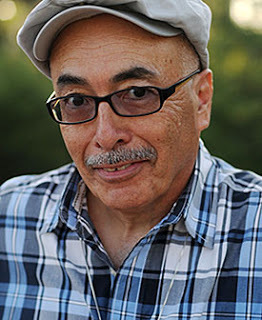
The son of migrant farmers in California, Herrera grew up in tents and trailers, changing schools. His father whistled like a dove; his mother sang songs from Mexico. They “loved the open sky and the earth when it is tender. They taught me that inside every word there can be kindness.”
Herrera has now written more than 28 books of poetry, novels and picture books and most recently, Portraits of Hispanic American Heroes, a 2015 Pura Belpré Honor Book showcasing inspirational Hispanic and Latino Americans. Much of his writing is autobiographical, like Calling the Doves, a picture book poem in English and Spanish about his early childhood.
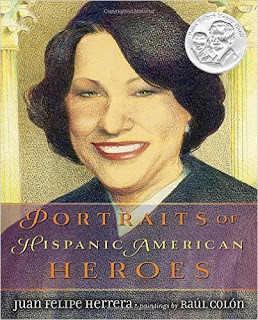
To celebrate this prolific poet, I am suggesting several writing prompts - any one of which could stimulate weeks of classroom or family discussion.
• What is one of the favorite stories your family tells? Why is it special to you?• If you have lived in many cities or houses, like Juan Felipe Herrera, what do you remember about one city or house that you really liked? What didn’t you like? Herrera’s character Juanito complains in Downtown Boy that “I never get to finish anything and when I go to class/I never got to start anything because everyone/is already done!”
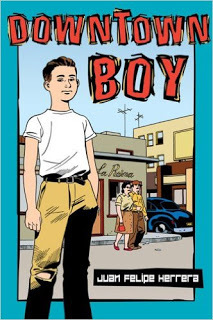
• Juanito has a tough loco cousin who always wants him to fight and even steal things, taunting him, “You wanna be a chump or a champ?” What do you do if someone teases you and tries to make you do something you know isn’t right?• If there are students in your class who speak and write English and Spanish - or another language - ask them to write a paragraph or a story in both languages. Herrera says he writes in English first, “then I translate into Spanish. But then I look at the Spanish and see the different flavors it adds, so I translate back into English. It keeps going back and forth until I have two related but stand-alone stories in the two languages….For kids who know both English and Spanish, the result is stereo because they can see how the story in one language comments on the story in the other language.”
Visit juanfelipepoet.comto find out more about this poet who “likes walking down the street with a pen in my hand,” and always seems to have a hat, a smile and a poem.
http://childrensbookguild.org/karen-leggett-abouraya
The United States officially has a new Poet Laureate this month - Juan Felipe Herrera, the first Hispanic poet in the position. Librarian of Congress James Billington says Herrera’s poems champion “voices, traditions and histories, as well as a cultural perspective, which is a vital part of our larger American identity.”

The son of migrant farmers in California, Herrera grew up in tents and trailers, changing schools. His father whistled like a dove; his mother sang songs from Mexico. They “loved the open sky and the earth when it is tender. They taught me that inside every word there can be kindness.”
Herrera has now written more than 28 books of poetry, novels and picture books and most recently, Portraits of Hispanic American Heroes, a 2015 Pura Belpré Honor Book showcasing inspirational Hispanic and Latino Americans. Much of his writing is autobiographical, like Calling the Doves, a picture book poem in English and Spanish about his early childhood.

To celebrate this prolific poet, I am suggesting several writing prompts - any one of which could stimulate weeks of classroom or family discussion.
• What is one of the favorite stories your family tells? Why is it special to you?• If you have lived in many cities or houses, like Juan Felipe Herrera, what do you remember about one city or house that you really liked? What didn’t you like? Herrera’s character Juanito complains in Downtown Boy that “I never get to finish anything and when I go to class/I never got to start anything because everyone/is already done!”

• Juanito has a tough loco cousin who always wants him to fight and even steal things, taunting him, “You wanna be a chump or a champ?” What do you do if someone teases you and tries to make you do something you know isn’t right?• If there are students in your class who speak and write English and Spanish - or another language - ask them to write a paragraph or a story in both languages. Herrera says he writes in English first, “then I translate into Spanish. But then I look at the Spanish and see the different flavors it adds, so I translate back into English. It keeps going back and forth until I have two related but stand-alone stories in the two languages….For kids who know both English and Spanish, the result is stereo because they can see how the story in one language comments on the story in the other language.”
Visit juanfelipepoet.comto find out more about this poet who “likes walking down the street with a pen in my hand,” and always seems to have a hat, a smile and a poem.
http://childrensbookguild.org/karen-leggett-abouraya
Published on September 14, 2015 14:00
September 7, 2015
Back to School with BALLOONS Lit. Journal
by Jacqueline Jules
In August, I was very pleased to see my poems, “The Math Beast” and “Thunder” featured in Issue 2 of a new online publication called BALLOONS Lit. Journal.
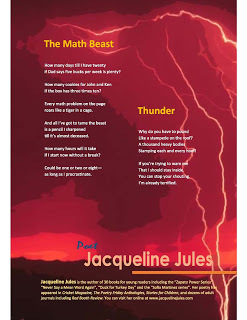
After reading the journal in its entirety, I would like to recommend this rich resource to teachers and young readers everywhere. BALLOONS Lit. Journal features work from both established and young writers from all around the world. It also includes work appropriate for a wide age range of students.
The inclusion of work by young people makes this a terrific model for young writers. Share the poem, “Rain,”by ten-year-old Sage as an excellent example of using descriptive details and then ask students to write their own weather poems.

Two fiction stories in this issue are told from the viewpoint of inanimate objects. “Knight Errant” is a clever chess story set in medieval times with a twist ending.
“Carnival Balloons” follows the worried thoughts of a balloon watching over a lost child.
Both of these stories could be used as models for writing from an object’s viewpoint, particularly a toy or game.
The art in Balloons Lit. Journal is utterly delightful. “The Earth—A Miracle” by Hyonju (Karen) Ahn could inspire writing about the earth, the solar system, and/or ecology.
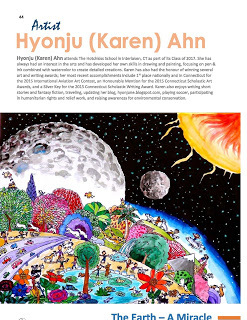
Ahn’s “City Lights” could make a terrific writing prompt and discussion for sensory details. Project the art on a smart board screen and brainstorm descriptive words for the busy sights and sounds depicted. Ask your students to describe a visit to the city or write a story about someone who is experiencing New York City for the first time.
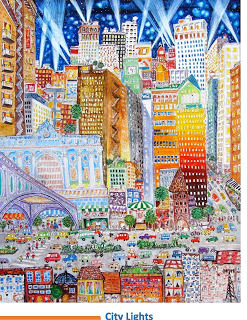
Attractively designed and available for free to educators, BALLOONS Lit. Journal, should be on your back-to-school list for writing workshop ideas. Check it out at http://www.balloons-lit-journal.com/issue-2.html
www.jacquelinejules.com
In August, I was very pleased to see my poems, “The Math Beast” and “Thunder” featured in Issue 2 of a new online publication called BALLOONS Lit. Journal.

After reading the journal in its entirety, I would like to recommend this rich resource to teachers and young readers everywhere. BALLOONS Lit. Journal features work from both established and young writers from all around the world. It also includes work appropriate for a wide age range of students.
The inclusion of work by young people makes this a terrific model for young writers. Share the poem, “Rain,”by ten-year-old Sage as an excellent example of using descriptive details and then ask students to write their own weather poems.

Two fiction stories in this issue are told from the viewpoint of inanimate objects. “Knight Errant” is a clever chess story set in medieval times with a twist ending.
“Carnival Balloons” follows the worried thoughts of a balloon watching over a lost child.
Both of these stories could be used as models for writing from an object’s viewpoint, particularly a toy or game.
The art in Balloons Lit. Journal is utterly delightful. “The Earth—A Miracle” by Hyonju (Karen) Ahn could inspire writing about the earth, the solar system, and/or ecology.

Ahn’s “City Lights” could make a terrific writing prompt and discussion for sensory details. Project the art on a smart board screen and brainstorm descriptive words for the busy sights and sounds depicted. Ask your students to describe a visit to the city or write a story about someone who is experiencing New York City for the first time.

Attractively designed and available for free to educators, BALLOONS Lit. Journal, should be on your back-to-school list for writing workshop ideas. Check it out at http://www.balloons-lit-journal.com/issue-2.html
www.jacquelinejules.com
Published on September 07, 2015 14:00
August 31, 2015
BREAKING OUT OF COMFORT ZONES
by Marcia Strykowski
I always used to think ‘Write What You Know’ was the best method for writing a story, but sometimes it’s surprising how changing it up can bring fresh ideas to your palette. In my books, Call Me Amy and Amy’s Choice, I have a connection to my main character—13-year-old Amy—because she lives in a tiny fishing village on the Maine coast that is very similar to where my grandparents lived all the while I was growing up. However, lately I’ve switched gears. My most recent work-in-progress is about a boy who lives in a big city.
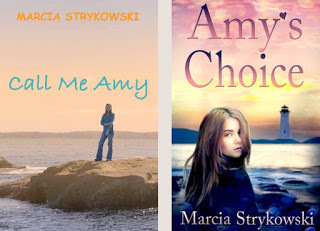
Breaking out of your comfort zone by changing the way you always write can set your writing free, while avoiding the usual setbacks and roadblocks. Rather than thinking, ‘oh, he wouldn’t do that…’ think instead, maybe she would!
Many fourth and fifth graders are more comfortable reading and rereading the same series of books over and over and this may factor into their writing, as well. Here’s a fun way for your students to come up with new ideas to write about.
Give everyone in your class a slip of paper. Have them write three items on the paper: main character’s name, main character’s age, setting (city, country, space, under the sea, school, etc.). Collect the slips in order and then pass them out again in reverse order. This takes the pressure off. Rather than writing about their own very familiar beloved characters, they’re now writing about someone or something else.
Have them ask themselves ‘what if?’ as they write their stories. What if there is a sudden snowstorm? What if the bike gets a flat tire? What if the main character isn’t even human, but an alien, superhero, or beast? Write fast, the first lines that come to them. They shouldn’t think about it too much, just go with their thoughts and keep writing.
Another story starter idea is to pass out pictures from old calendars and have your students use the scene for their setting. No matter which methods they use, changing it up is bound to uncover all sorts of new possibilities for their stories.
After these mind stretching exercises, students can go back to ‘writing what they know,’ but hopefully they’ll be less wary of experimenting and including new ideas. Happy writing!
 BIO: Marcia Strykowski works at a public library. Earlier, after earning her BS in Fine Arts, she worked for seven years in textbook publishing. She is a member of SCBWI. After numerous magazine and anthology contributions, Call Me Amy was Marcia’s first novel. It was chosen for Bank Street College of Education’s Best Books of 2013. Amy's Choice , a sequel to Call Me Amy, was released the following year. Both tween novels were published by Luminis Books. You can find out more about her and her books at http://marciastrykowski.com/
BIO: Marcia Strykowski works at a public library. Earlier, after earning her BS in Fine Arts, she worked for seven years in textbook publishing. She is a member of SCBWI. After numerous magazine and anthology contributions, Call Me Amy was Marcia’s first novel. It was chosen for Bank Street College of Education’s Best Books of 2013. Amy's Choice , a sequel to Call Me Amy, was released the following year. Both tween novels were published by Luminis Books. You can find out more about her and her books at http://marciastrykowski.com/
I always used to think ‘Write What You Know’ was the best method for writing a story, but sometimes it’s surprising how changing it up can bring fresh ideas to your palette. In my books, Call Me Amy and Amy’s Choice, I have a connection to my main character—13-year-old Amy—because she lives in a tiny fishing village on the Maine coast that is very similar to where my grandparents lived all the while I was growing up. However, lately I’ve switched gears. My most recent work-in-progress is about a boy who lives in a big city.

Breaking out of your comfort zone by changing the way you always write can set your writing free, while avoiding the usual setbacks and roadblocks. Rather than thinking, ‘oh, he wouldn’t do that…’ think instead, maybe she would!
Many fourth and fifth graders are more comfortable reading and rereading the same series of books over and over and this may factor into their writing, as well. Here’s a fun way for your students to come up with new ideas to write about.
Give everyone in your class a slip of paper. Have them write three items on the paper: main character’s name, main character’s age, setting (city, country, space, under the sea, school, etc.). Collect the slips in order and then pass them out again in reverse order. This takes the pressure off. Rather than writing about their own very familiar beloved characters, they’re now writing about someone or something else.
Have them ask themselves ‘what if?’ as they write their stories. What if there is a sudden snowstorm? What if the bike gets a flat tire? What if the main character isn’t even human, but an alien, superhero, or beast? Write fast, the first lines that come to them. They shouldn’t think about it too much, just go with their thoughts and keep writing.
Another story starter idea is to pass out pictures from old calendars and have your students use the scene for their setting. No matter which methods they use, changing it up is bound to uncover all sorts of new possibilities for their stories.
After these mind stretching exercises, students can go back to ‘writing what they know,’ but hopefully they’ll be less wary of experimenting and including new ideas. Happy writing!
 BIO: Marcia Strykowski works at a public library. Earlier, after earning her BS in Fine Arts, she worked for seven years in textbook publishing. She is a member of SCBWI. After numerous magazine and anthology contributions, Call Me Amy was Marcia’s first novel. It was chosen for Bank Street College of Education’s Best Books of 2013. Amy's Choice , a sequel to Call Me Amy, was released the following year. Both tween novels were published by Luminis Books. You can find out more about her and her books at http://marciastrykowski.com/
BIO: Marcia Strykowski works at a public library. Earlier, after earning her BS in Fine Arts, she worked for seven years in textbook publishing. She is a member of SCBWI. After numerous magazine and anthology contributions, Call Me Amy was Marcia’s first novel. It was chosen for Bank Street College of Education’s Best Books of 2013. Amy's Choice , a sequel to Call Me Amy, was released the following year. Both tween novels were published by Luminis Books. You can find out more about her and her books at http://marciastrykowski.com/
Published on August 31, 2015 14:00
August 24, 2015
SHOWING CHARACTER THROUGH ACTION
by Claudia Mills
One of the cardinal rules of writing is “Show, don’t tell.” This means that rather than telling readers that your character is bossy, you need to show her actually being bossy. Rather than telling readers that another character loves to daydream, you need to showher lost in reverie – and show us what the content of her fantasy is.
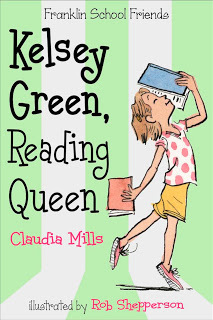
In my new series, Franklin School Friends, my characters are defined by their interests and passions. Kelsey (Kelsey Green, Reading Queen) loves to read. Annika (Annika Riz: Math Whiz) loves math. Izzy (Izzy Barr, Running Star) loves to run. You get the idea! In each book, my challenge is to find a way for the girls to support one another (in trying to win a reading contest, a Sudoku contest, or a race) while using their own distinctive talent and abilities.
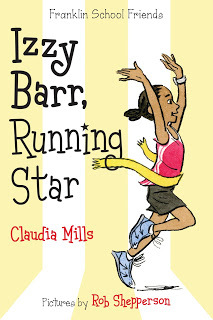
So: as Izzy is trying to win a 10K race, Kelsey inspires her with the story of Atalanta’s famous race in Greek mythology and Annika helps her calculate how fast she needs to run each kilometer to beat her rival. When Kelsey suspects her rival, Simon, of cheating during a schoolwide reading contest, Annika figures out how many pages Simon would need to read in an hour to make good on his reading claims; Izzy spies on Simon with the plan of running fast if she gets caught. Here’s a way to share this characterization challenge with students.
1) Let students pick a fun activity to be the focus of a scene. Examples might be: running a race, baking a cake, building a snow fort, starting a lemonade stand.
2) Choose names for three characters to be part of the scene, preferably with a mix of boys and girls (and not using names of any kids in the class).
3) Give each kid a character trait (e.g., shy, imaginative, clumsy, funny, determined, impatient, reckless, conceited, talkative). Or: give each kid a passion/talent (loves sports, science, math, music, reading).
4) Then: how can we SHOW this in the scene? If our characters are baking a cake, what would the shy character be doing? The imaginative one? The clumsy one? The funny one? What would the sports-lover contribute to the baking? Maybe she’d volunteer to use her arm muscles doing the mixing or she’d be jogging in place as the cake bakes. What would the scientist kid contribute? Maybe wondering how differently the cake would turn out if they left out the flour or baking powder? What would the musical kid be doing? Maybe making up a cake-baking song for them all to sing?
The takeaway point for the students is: character is shown through ACTION. We know what kind of person someone is by seeing what he DOES. So: provide a fun activity, gather together a group of imaginary kids, and let them reveal themselves to us!
 Claudia Mills is the author of over 50 books for young readers, including How Oliver Olson Changed the World (an ALA Notable Book of the Year) and The Trouble with Ants (which just received a starred review in Publishers Weekly), as well as the Franklin School Friends series of chapter books from Farrar, Straus & Giroux. Claudia lives in Boulder, Colorado, with her family and her cat, Snickers. Visit her at www.claudiamillsauthor.com.
Claudia Mills is the author of over 50 books for young readers, including How Oliver Olson Changed the World (an ALA Notable Book of the Year) and The Trouble with Ants (which just received a starred review in Publishers Weekly), as well as the Franklin School Friends series of chapter books from Farrar, Straus & Giroux. Claudia lives in Boulder, Colorado, with her family and her cat, Snickers. Visit her at www.claudiamillsauthor.com.
One of the cardinal rules of writing is “Show, don’t tell.” This means that rather than telling readers that your character is bossy, you need to show her actually being bossy. Rather than telling readers that another character loves to daydream, you need to showher lost in reverie – and show us what the content of her fantasy is.

In my new series, Franklin School Friends, my characters are defined by their interests and passions. Kelsey (Kelsey Green, Reading Queen) loves to read. Annika (Annika Riz: Math Whiz) loves math. Izzy (Izzy Barr, Running Star) loves to run. You get the idea! In each book, my challenge is to find a way for the girls to support one another (in trying to win a reading contest, a Sudoku contest, or a race) while using their own distinctive talent and abilities.

So: as Izzy is trying to win a 10K race, Kelsey inspires her with the story of Atalanta’s famous race in Greek mythology and Annika helps her calculate how fast she needs to run each kilometer to beat her rival. When Kelsey suspects her rival, Simon, of cheating during a schoolwide reading contest, Annika figures out how many pages Simon would need to read in an hour to make good on his reading claims; Izzy spies on Simon with the plan of running fast if she gets caught. Here’s a way to share this characterization challenge with students.
1) Let students pick a fun activity to be the focus of a scene. Examples might be: running a race, baking a cake, building a snow fort, starting a lemonade stand.
2) Choose names for three characters to be part of the scene, preferably with a mix of boys and girls (and not using names of any kids in the class).
3) Give each kid a character trait (e.g., shy, imaginative, clumsy, funny, determined, impatient, reckless, conceited, talkative). Or: give each kid a passion/talent (loves sports, science, math, music, reading).
4) Then: how can we SHOW this in the scene? If our characters are baking a cake, what would the shy character be doing? The imaginative one? The clumsy one? The funny one? What would the sports-lover contribute to the baking? Maybe she’d volunteer to use her arm muscles doing the mixing or she’d be jogging in place as the cake bakes. What would the scientist kid contribute? Maybe wondering how differently the cake would turn out if they left out the flour or baking powder? What would the musical kid be doing? Maybe making up a cake-baking song for them all to sing?
The takeaway point for the students is: character is shown through ACTION. We know what kind of person someone is by seeing what he DOES. So: provide a fun activity, gather together a group of imaginary kids, and let them reveal themselves to us!
 Claudia Mills is the author of over 50 books for young readers, including How Oliver Olson Changed the World (an ALA Notable Book of the Year) and The Trouble with Ants (which just received a starred review in Publishers Weekly), as well as the Franklin School Friends series of chapter books from Farrar, Straus & Giroux. Claudia lives in Boulder, Colorado, with her family and her cat, Snickers. Visit her at www.claudiamillsauthor.com.
Claudia Mills is the author of over 50 books for young readers, including How Oliver Olson Changed the World (an ALA Notable Book of the Year) and The Trouble with Ants (which just received a starred review in Publishers Weekly), as well as the Franklin School Friends series of chapter books from Farrar, Straus & Giroux. Claudia lives in Boulder, Colorado, with her family and her cat, Snickers. Visit her at www.claudiamillsauthor.com.
Published on August 24, 2015 14:00
August 17, 2015
Get Out Your Crayons!
by Joan Waites
In my last blog post, I outlined an art and writing activity based on the classic children’s book, Harold And The Purple Crayon. Instead of using just one purple crayon (as per the exercise and the book), now it’s time to get out the whole pack!
It’s hard miss the relatively new adult coloring book craze when you walk into a book store. Coloring books are displayed at every turn. From simple scenes to intricate patterns, lush florals, and whimsical animals, there is something for every age and interest.
The new “queen” of coloring books, UK illustrator Johanna Basford, has even topped the recent best-seller lists with the following titles:
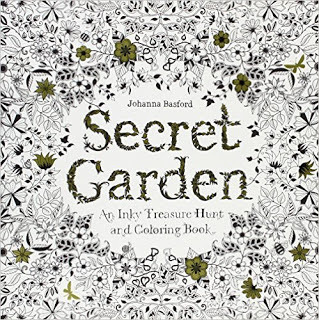
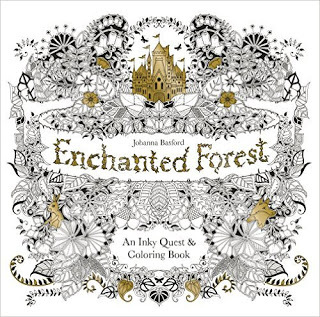
Coloring provides a great way to relax and de-stress, while at the same time trains the brain to focus and work on fine motor skills. Using crayons, markers, or colored pencils, a coloring session is not only fun, but therapeutic for adults and kids alike.
To add a writing exercise that can be used with a coloring page, ask your students to create a story based on the illustration they are coloring. Below is a sample of a page I created last year for a coloring book used by patients at Saint Jude’s Children’s Hospital. Print the page on 81/2 X 11 paper and color.
 Created by Joan Waites
Created by Joan Waites
Ask your students to imagine the story happening in the picture. Where is the girl going? What are the elephants doing? Who is the bird? The monkey? Where does this story take place?
Enjoy some coloring time, and enjoy these last weeks of summer!
www.joanwaites.com
In my last blog post, I outlined an art and writing activity based on the classic children’s book, Harold And The Purple Crayon. Instead of using just one purple crayon (as per the exercise and the book), now it’s time to get out the whole pack!
It’s hard miss the relatively new adult coloring book craze when you walk into a book store. Coloring books are displayed at every turn. From simple scenes to intricate patterns, lush florals, and whimsical animals, there is something for every age and interest.
The new “queen” of coloring books, UK illustrator Johanna Basford, has even topped the recent best-seller lists with the following titles:


Coloring provides a great way to relax and de-stress, while at the same time trains the brain to focus and work on fine motor skills. Using crayons, markers, or colored pencils, a coloring session is not only fun, but therapeutic for adults and kids alike.
To add a writing exercise that can be used with a coloring page, ask your students to create a story based on the illustration they are coloring. Below is a sample of a page I created last year for a coloring book used by patients at Saint Jude’s Children’s Hospital. Print the page on 81/2 X 11 paper and color.
 Created by Joan Waites
Created by Joan WaitesAsk your students to imagine the story happening in the picture. Where is the girl going? What are the elephants doing? Who is the bird? The monkey? Where does this story take place?
Enjoy some coloring time, and enjoy these last weeks of summer!
www.joanwaites.com
Published on August 17, 2015 14:00
August 10, 2015
WRITING CONNECTIONS WITH ERIN HAGAR
by Mary Quattlebaum
Julia Child: An Extraordinary Life in Words and Pictures (DuoPress, 2015) brings culinary pioneer Julia Child to fascinating life. Author Erin Hagar and illustrator Joanna Gorham create an innovative biography that combines vivid, informative prose with wordless double-page spreads that dramatize key moments in Julia’s life.
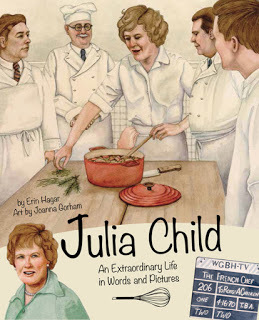
Below are a few writing prompts for the classroom or for individual writers ages 8 and up. (The biography’s engaging form is similar to that of Brian Selznick’s Caldecott-winning novel The Invention of Hugo Cabret.)
Writing About Professional Hopes: Many young people seem to have only a vague idea of what a specific profession involves, or they are starstruck and seem to think that being a professional singer or athlete means doing so only at the top. This biography takes a close look at someone with an expertise—cooking, food writing—that may intrigue young people.
Classroom Discussion: Ask students to read this or the biography of another noteworthy figure from the 20th or 21st centuries. Have them jot down answers to the following: Why does this person intrigue you? How did the person become involved in his/her life’s work? What were setbacks? How were they handled?
Research: Have students do some Internet research on professions/jobs they may be interested in. Why does this work interest them? What does training involve? What are some tasks/activities involved on a regular basis?
Classroom Writing: Brainstorm questions to ask someone who does this type of work. (How did you get started? When did you know this job/profession is what you wanted to do? What’s the funniest/most surprising thing that ever happened to you on the job? The most challenging? Have students ask these questions of someone (preferably not in their immediate family). In addition to adults in the neighborhood or extended family, youngsters might look at websites for organizations or professional associations. Many have public relations departments or do educational outreach, and the websites can be helpful sources when students are doing research or trying to identify possible interviewees. Ask students to write what they discovered in a few paragraphs.
Sharing: Mount the writing on a bulletin board, and give youngsters a chance to share more information or ask questions of one another. What was the most surprising or favorite thing they learned about this job or person?
For More Information: To learn more about the professions of chef, author, and illustrator, check the official website for Julia Child , Erin Hagar, and Joanna Gorham,
 Erin Hagar Related Projects/Reading:This biography of Julia Child makes a wonderful book for a classroom library. Or educators might check this one and other biographies of recent figures out of the library and display them in the classroom. Even a kid picking up and briefly leafing through a biography can learn a lot. It’s hard for kids to imagine possible life paths unless they “see” them, whether on TV, in the neighborhood, in their family or those of their friends, or in books.
Erin Hagar Related Projects/Reading:This biography of Julia Child makes a wonderful book for a classroom library. Or educators might check this one and other biographies of recent figures out of the library and display them in the classroom. Even a kid picking up and briefly leafing through a biography can learn a lot. It’s hard for kids to imagine possible life paths unless they “see” them, whether on TV, in the neighborhood, in their family or those of their friends, or in books.
Too often, biographies for youngsters highlight worthy artists, writers, activists, athletes, and politicians. They’re all important to the historical landscape, of course, but where are the biographies of those with recent accomplishments in the fields of science, agriculture, the culinary arts, business, and engineering? Where are the life stories that might guide and inspire youngsters with an interest in professions beyond those usually featured? www.maryquattlebaum.com
Julia Child: An Extraordinary Life in Words and Pictures (DuoPress, 2015) brings culinary pioneer Julia Child to fascinating life. Author Erin Hagar and illustrator Joanna Gorham create an innovative biography that combines vivid, informative prose with wordless double-page spreads that dramatize key moments in Julia’s life.

Below are a few writing prompts for the classroom or for individual writers ages 8 and up. (The biography’s engaging form is similar to that of Brian Selznick’s Caldecott-winning novel The Invention of Hugo Cabret.)
Writing About Professional Hopes: Many young people seem to have only a vague idea of what a specific profession involves, or they are starstruck and seem to think that being a professional singer or athlete means doing so only at the top. This biography takes a close look at someone with an expertise—cooking, food writing—that may intrigue young people.
Classroom Discussion: Ask students to read this or the biography of another noteworthy figure from the 20th or 21st centuries. Have them jot down answers to the following: Why does this person intrigue you? How did the person become involved in his/her life’s work? What were setbacks? How were they handled?
Research: Have students do some Internet research on professions/jobs they may be interested in. Why does this work interest them? What does training involve? What are some tasks/activities involved on a regular basis?
Classroom Writing: Brainstorm questions to ask someone who does this type of work. (How did you get started? When did you know this job/profession is what you wanted to do? What’s the funniest/most surprising thing that ever happened to you on the job? The most challenging? Have students ask these questions of someone (preferably not in their immediate family). In addition to adults in the neighborhood or extended family, youngsters might look at websites for organizations or professional associations. Many have public relations departments or do educational outreach, and the websites can be helpful sources when students are doing research or trying to identify possible interviewees. Ask students to write what they discovered in a few paragraphs.
Sharing: Mount the writing on a bulletin board, and give youngsters a chance to share more information or ask questions of one another. What was the most surprising or favorite thing they learned about this job or person?
For More Information: To learn more about the professions of chef, author, and illustrator, check the official website for Julia Child , Erin Hagar, and Joanna Gorham,
 Erin Hagar Related Projects/Reading:This biography of Julia Child makes a wonderful book for a classroom library. Or educators might check this one and other biographies of recent figures out of the library and display them in the classroom. Even a kid picking up and briefly leafing through a biography can learn a lot. It’s hard for kids to imagine possible life paths unless they “see” them, whether on TV, in the neighborhood, in their family or those of their friends, or in books.
Erin Hagar Related Projects/Reading:This biography of Julia Child makes a wonderful book for a classroom library. Or educators might check this one and other biographies of recent figures out of the library and display them in the classroom. Even a kid picking up and briefly leafing through a biography can learn a lot. It’s hard for kids to imagine possible life paths unless they “see” them, whether on TV, in the neighborhood, in their family or those of their friends, or in books.Too often, biographies for youngsters highlight worthy artists, writers, activists, athletes, and politicians. They’re all important to the historical landscape, of course, but where are the biographies of those with recent accomplishments in the fields of science, agriculture, the culinary arts, business, and engineering? Where are the life stories that might guide and inspire youngsters with an interest in professions beyond those usually featured? www.maryquattlebaum.com
Published on August 10, 2015 14:00
August 3, 2015
LET ART INSPIRE WORDS
by Karen Leggett Abouraya
During a recent visit to a Van Gogh exhibit with my young adult daughter, we listened to a cell phone description of the technical differences among the artist’s numerous paintings of a postman. Then we picked up a pamphlet describing the friendship Van Gogh enjoyed with the postman Joseph Roulin and his wife. “That’s what’s important to know!” proclaimed my daughter, who promptly bought the Washington, D.C., subway card displaying Van Gogh’s postman.
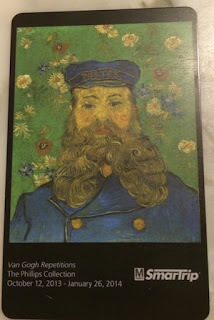
So why not let a work of art inspire youngsters to write their own stories?
Find paintings in a local museum or art gallery, online or in an art history book. Ask children to look at a painting with several questions in mind as they imagine their story:
- who are the people in the painting?- how are they related or connected to each other? - what were they doing just before the painter fixed them on the canvas? what will they do next?- is the weather or atmosphere in the painting important to your story - is it a bright sunny day or a spooky, stormy night?- does the story have a happy ending or is there mystery or sadness?
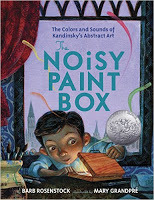
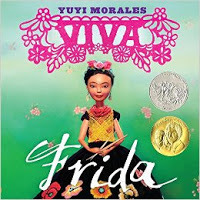
If children choose a landscape or building, they can create characters to fill the space. Or children can read an artist biography and then write their story. Two of this year’s Caldecott Honor books are biographies of artists - The Noisy Paint Box: The Colors and Sounds of Kandinsky’s Abstract Art by Barb Rosenstock, illustrated by Mary Grandpré and Yuyi Morales’Viva Frida. In the Noisy Paint Box we read how Vasya Kandinsky saw “Thundering arches of aqua and ebony, with shrill points of cobalt and saffron…Vasya heard the colors singing…and saw the music dancing.” With those noisy colors in mind, what words and stories could be inspired by Kandinsky’s Two Ovals or White Zig Zag?

http://childrensbookguild.org/karen-leggett-abouraya
During a recent visit to a Van Gogh exhibit with my young adult daughter, we listened to a cell phone description of the technical differences among the artist’s numerous paintings of a postman. Then we picked up a pamphlet describing the friendship Van Gogh enjoyed with the postman Joseph Roulin and his wife. “That’s what’s important to know!” proclaimed my daughter, who promptly bought the Washington, D.C., subway card displaying Van Gogh’s postman.

So why not let a work of art inspire youngsters to write their own stories?
Find paintings in a local museum or art gallery, online or in an art history book. Ask children to look at a painting with several questions in mind as they imagine their story:
- who are the people in the painting?- how are they related or connected to each other? - what were they doing just before the painter fixed them on the canvas? what will they do next?- is the weather or atmosphere in the painting important to your story - is it a bright sunny day or a spooky, stormy night?- does the story have a happy ending or is there mystery or sadness?


If children choose a landscape or building, they can create characters to fill the space. Or children can read an artist biography and then write their story. Two of this year’s Caldecott Honor books are biographies of artists - The Noisy Paint Box: The Colors and Sounds of Kandinsky’s Abstract Art by Barb Rosenstock, illustrated by Mary Grandpré and Yuyi Morales’Viva Frida. In the Noisy Paint Box we read how Vasya Kandinsky saw “Thundering arches of aqua and ebony, with shrill points of cobalt and saffron…Vasya heard the colors singing…and saw the music dancing.” With those noisy colors in mind, what words and stories could be inspired by Kandinsky’s Two Ovals or White Zig Zag?

http://childrensbookguild.org/karen-leggett-abouraya
Published on August 03, 2015 14:00
July 27, 2015
SWEEPSTAKES, SLOGANS, AND DEATH BY TOILET PAPER
by Jacqueline JulesHave you ever thought about slogan writing? Kentucky Fried Chicken is “Finger lickin’ good.” At Burger King, you can expect to “Have it Your Way.” And everyone wants to go to Disneyland because it is “The Happiest Place on Earth.”
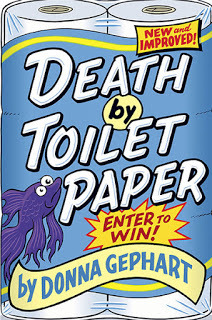
In a touching and funny middle grade novel, Death by Toilet Paper, seventh grader Ben loves to enter sweepstakes. He enters as many contests as he can, optimistically hoping to help his widowed mother pay the bills. Slogan contests offer the best chance of winning because not everyone is creative or persistent enough to take the time to write a good advertisement. Ben dreams of winning a big prize from the Royal-T Bathroom Tissue Company. He puts serious thought into a clever slogan in between dealing with a boisterous grandfather, a bully at school, and a best friend who loves horror make-up. And to add to the fun, every chapter begins with a FUNtastic fact about bathrooms. Did you know that most toilets flush in the key of E-flat? Or that Americans use an average of 57 sheets of toilet paper each day? Death by Toilet Paper by Donna Gephart would make a great read aloud in the classroom. Your students will find Ben to be a lovable and spunky character worth rooting for. The book should also inspire your students to try their hand at slogan writing. Here are some tips to remember:1. Brief is better. No more than one sentence long.2. Make it catchy. A slogan should have a good rhythm and be easy to say.3. Capture the essence. A slogan tells customers why they want the product or service.4. Originality is memorable. Don’t recycle old ads. Attract attention with something new. And when your class is finished writing their own slogans, maybe your students will want to research some FUNtastic facts about a topic of their choice. Did you know that it takes 384 trees to produce the toilet paper one person uses in a lifetime?www.jacquelinejules.com

In a touching and funny middle grade novel, Death by Toilet Paper, seventh grader Ben loves to enter sweepstakes. He enters as many contests as he can, optimistically hoping to help his widowed mother pay the bills. Slogan contests offer the best chance of winning because not everyone is creative or persistent enough to take the time to write a good advertisement. Ben dreams of winning a big prize from the Royal-T Bathroom Tissue Company. He puts serious thought into a clever slogan in between dealing with a boisterous grandfather, a bully at school, and a best friend who loves horror make-up. And to add to the fun, every chapter begins with a FUNtastic fact about bathrooms. Did you know that most toilets flush in the key of E-flat? Or that Americans use an average of 57 sheets of toilet paper each day? Death by Toilet Paper by Donna Gephart would make a great read aloud in the classroom. Your students will find Ben to be a lovable and spunky character worth rooting for. The book should also inspire your students to try their hand at slogan writing. Here are some tips to remember:1. Brief is better. No more than one sentence long.2. Make it catchy. A slogan should have a good rhythm and be easy to say.3. Capture the essence. A slogan tells customers why they want the product or service.4. Originality is memorable. Don’t recycle old ads. Attract attention with something new. And when your class is finished writing their own slogans, maybe your students will want to research some FUNtastic facts about a topic of their choice. Did you know that it takes 384 trees to produce the toilet paper one person uses in a lifetime?www.jacquelinejules.com
Published on July 27, 2015 14:00
July 20, 2015
WRITING ABOUT SUMMER JOY
by Alison Ashley Formento
It’s summer and when you’re not outside enjoying the beach or eating ice cream, you might be heading inside to cool off at a movie. Inside Out is the new animated feature from Disney Pixar and it’s worth your time to see this delightful film. This is no movie review, but when a story engages your emotions, whether in a book or a film, it’s something you want to share with others.
What’s your joy this summer? Is it a special vacation with your family? Biking with friends? Camping under the stars? Some people may prefer body-surfing at the beach, while others enjoy a lazy afternoon under a tree reading a new book.
Joy comes to each of us differently, and if you see Inside Out , a part of the film’s theme is how the feeling of joy or extreme happiness is deeply appreciated, especially after a sad or disappointing experience.
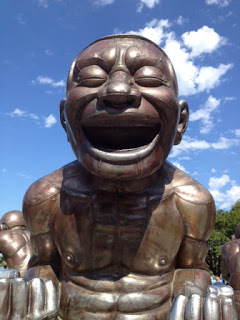
Joy-Sadness-Joy
Write about something that brings you joy in the summer. What makes you smile on a nice summer day? Example: A perfect summer afternoon at a baseball game with your favorite cousin. Expand by describing the sights, sounds, smells, and experiences at this baseball game that help make you feel joyful.
Write about the opposite of your joyful experience. Example: It begins to rain at the baseball game, stopping all play, and your favorite cousin’s train is delayed and he won’t make it after all. Expand details to show the elements of this experience, which bring sadness.
Write how joy returns after feeling sad.Example: Perhaps the rain stops, a rainbow appears, and the baseball game continues. Best of all, your cousin arrives to surprise you at the game. Write details to show how this joy is fuller now, because it’s more appreciated after the sadness you experienced.
www.alisonashleyformento.com
It’s summer and when you’re not outside enjoying the beach or eating ice cream, you might be heading inside to cool off at a movie. Inside Out is the new animated feature from Disney Pixar and it’s worth your time to see this delightful film. This is no movie review, but when a story engages your emotions, whether in a book or a film, it’s something you want to share with others.
What’s your joy this summer? Is it a special vacation with your family? Biking with friends? Camping under the stars? Some people may prefer body-surfing at the beach, while others enjoy a lazy afternoon under a tree reading a new book.
Joy comes to each of us differently, and if you see Inside Out , a part of the film’s theme is how the feeling of joy or extreme happiness is deeply appreciated, especially after a sad or disappointing experience.

Joy-Sadness-Joy
Write about something that brings you joy in the summer. What makes you smile on a nice summer day? Example: A perfect summer afternoon at a baseball game with your favorite cousin. Expand by describing the sights, sounds, smells, and experiences at this baseball game that help make you feel joyful.
Write about the opposite of your joyful experience. Example: It begins to rain at the baseball game, stopping all play, and your favorite cousin’s train is delayed and he won’t make it after all. Expand details to show the elements of this experience, which bring sadness.
Write how joy returns after feeling sad.Example: Perhaps the rain stops, a rainbow appears, and the baseball game continues. Best of all, your cousin arrives to surprise you at the game. Write details to show how this joy is fuller now, because it’s more appreciated after the sadness you experienced.
www.alisonashleyformento.com
Published on July 20, 2015 14:00
July 13, 2015
SUSAN L. ROTH: A SPECIAL COLLABORATION IN MISSOURI
Susan L. Roth, the award winning author and illustrator of 45 books including Hands Around the Library, Parrots Over Puerto Rico, and The Mangrove Tree was recently a part of an amazing writing program in Blue Springs, Missouri. In a guest blog, she shares her experiences at Pencil Tips Writing Workshop.
A summer school writing program involving 900 students was created and initiated by the Deputy Superintendent of Curriculum and Instruction, for the entire Blue Springs R-IV School District (Dr. Annette Seago), later working together with Liz Nealon, co-creator and publisher of StarWalk Kids Media, the E-publisher of many of my books.
The participating children, from grades K-8, were required to write a non-fiction work for an all-program competition. Separate winners were to be chosen respectively, one from each of these three separate age groups: kindergarten-2ndgrade, 3rd-5th, and 6th-8th.
 All children were then exposed extensively to age-appropriate non-fiction books, and especially, after I had agreed to participate, to ones I had written and/or illustrated. My part in this project was to help to choose the final winner in the 3rd-5th category, and then to illustrate the winner’s book for eventual e-publication.
All children were then exposed extensively to age-appropriate non-fiction books, and especially, after I had agreed to participate, to ones I had written and/or illustrated. My part in this project was to help to choose the final winner in the 3rd-5th category, and then to illustrate the winner’s book for eventual e-publication.
The writing teachers amazingly sifted through every single one of the 900 entries. They selected five first cut winners for me (and my publisher) to read. Our job was to choose the one that would be best for me to illustrate and for the publisher to publish.
The plan: to make a REAL BOOK happen.
All five selections were surprisingly excellent, each diverse in subject and style, and each interesting. With difficulty, we finally chose PLANTS AND ANIMALS, written by a 9-year-old named Violetta. This one, we agreed, was perfect for the project. The publisher notified the program coordinators and they, our winner, Violetta, who was ecstatic.
Warning: This is not, everyone admits, a project designed for equal opportunities for each of the 900 children. But it was so successful with its one-to-one design, that I, as well as the others, feel we need to take advantage of the happening and work to find a way to broaden the wonderful experience.
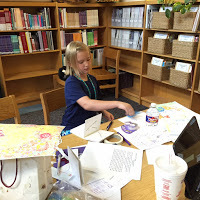 In the attractive library at Daniel Young Elementary School in Blue Springs, Missouri, Violetta and I sat at one of the several library tables for about four hours without getting up! Two writing teachers were also in attendance. Together Violetta and I explored the way to illustrate a non-fiction text, one step at a time.
In the attractive library at Daniel Young Elementary School in Blue Springs, Missouri, Violetta and I sat at one of the several library tables for about four hours without getting up! Two writing teachers were also in attendance. Together Violetta and I explored the way to illustrate a non-fiction text, one step at a time.
Together we:1-read and re-read the text;2-we divided the text into pages;3-we made a quick storyboard;4-we corrected the storyboard;5-we made a tiny dummy to make sure that our pagination was correct (it wasn’t, we corrected it);6-we made a small, but precisely proportional-to-the-book-size dummy, and numbered its pages. We cut the text into pieces, and taped each piece to its proper page;7-we discussed possible images and sketched several possibilities on separate papers;8-we sketched our ideas directly into the real dummy. Sometimes we disagreed. We talked out our different approaches until we reached agreement. Each of us did this without feeling that one of us was ever dominating the project.
And at that point this amazing 9-year-old child, who had been sitting still for almost four straight hours with a stranger she just met, jumped up and confessed that she HAD to run a little. And she flew from one end of the library to the other again and again until she was out of breath. Then she flopped back down in her chair, renewed.
We went back to work for a bit after that, refining the drawings, but mostly just admiring what we had accomplished together, and then school was dismissed and Violetta was out the door.
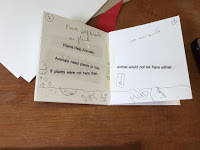
And I was swept away to my hotel where I was to create the first page of art to present at the ceremonies on Wednesday.
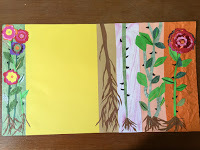 I must admit that before I went to work with Violetta my feelings about this project were a little mixed. Certainly it is not revolutionary to feel that the children themselves should have created their own illustrations for their own books. Actually, I raised my concerns as soon as I arrived at Daniel Young School. But, I was told, this was not our project this time, even though it might be, another time. THIS summer program in Blue Springs R-14 School District was for WRITING.
I must admit that before I went to work with Violetta my feelings about this project were a little mixed. Certainly it is not revolutionary to feel that the children themselves should have created their own illustrations for their own books. Actually, I raised my concerns as soon as I arrived at Daniel Young School. But, I was told, this was not our project this time, even though it might be, another time. THIS summer program in Blue Springs R-14 School District was for WRITING.
And all the children DID write. Their writing efforts were taken very seriously by the official mentors. The participants were individually named and each was individually awarded with a special writing medal and a special certificate at the ceremony on Wednesday. All their writings were exhibited on tables set out in the hallways of the school. Most of the parents came to the ceremony so that there was a good audience for all.
I thought all of this was wonderful. But none of this was my takeaway.
The extraordinary thing that happened was the adult to adult collaboration, one to one, between Violetta and myself as we were sitting together quietly for all those adult hours in the library. It was a genuine collaboration, and our 62 year age difference (who’s counting and none of your business, besides) did not enter into the equation.
Could the other 899 kids ever have a similar experience? Would I, ever in a million years, be capable of repeating this lovely interval another 899 times? NO! is the quick and true answer.
But, the two dedicated and gifted writing teachers who silently witnessed this amazing, lovely teaching event, and I, are all determined to figure out a way to do this (or maybe at least something LIKE this) for more children, more often.
We are starting with a proposed Skype session, scheduled for July, to coincide with an annual writing teachers symposium also to be held in Blue Springs, Missouri.
My most important job is going to be to try to analyze the magic that took place. I hope to be able to transmit the taste of the moment. Our collective goal is to figure out a way that eventually the children themselves will be able to reproduce the one on one exchange, with each participant wearing his own hat: that would be the writer, writing, and the illustrator, illustrating, but with each, LISTENING, and each THINKING, and each COLLABORATING, each, working towards their mutual common goal, TOGETHER.
I suppose this is what is happening, internally, when one is both the writer and the illustrator as I usually am, but somehow, with the two individuals working together the process becomes all the more exciting.
The amazing, happy alliance, the give and take, the discussion and the execution by the two different people, TOGETHER, was all so very special. I hope that this report can convey a little of our shared excitement, and that perhaps it can inspire future experiments, with intense involvement, one on one, but completely together.
As for our own experiment, I’m sure that our day was one that Violetta will hold dear forever. Surely I will as well.
Susan L. Roth
P. S. I am presently working on completing the rest of the art for Violetta’s book. It will be published as soon as I finish, by StarWalk Kids Media. Please look for it! Fan mail cheerfully accepted.
A summer school writing program involving 900 students was created and initiated by the Deputy Superintendent of Curriculum and Instruction, for the entire Blue Springs R-IV School District (Dr. Annette Seago), later working together with Liz Nealon, co-creator and publisher of StarWalk Kids Media, the E-publisher of many of my books.
The participating children, from grades K-8, were required to write a non-fiction work for an all-program competition. Separate winners were to be chosen respectively, one from each of these three separate age groups: kindergarten-2ndgrade, 3rd-5th, and 6th-8th.
 All children were then exposed extensively to age-appropriate non-fiction books, and especially, after I had agreed to participate, to ones I had written and/or illustrated. My part in this project was to help to choose the final winner in the 3rd-5th category, and then to illustrate the winner’s book for eventual e-publication.
All children were then exposed extensively to age-appropriate non-fiction books, and especially, after I had agreed to participate, to ones I had written and/or illustrated. My part in this project was to help to choose the final winner in the 3rd-5th category, and then to illustrate the winner’s book for eventual e-publication.The writing teachers amazingly sifted through every single one of the 900 entries. They selected five first cut winners for me (and my publisher) to read. Our job was to choose the one that would be best for me to illustrate and for the publisher to publish.
The plan: to make a REAL BOOK happen.
All five selections were surprisingly excellent, each diverse in subject and style, and each interesting. With difficulty, we finally chose PLANTS AND ANIMALS, written by a 9-year-old named Violetta. This one, we agreed, was perfect for the project. The publisher notified the program coordinators and they, our winner, Violetta, who was ecstatic.
Warning: This is not, everyone admits, a project designed for equal opportunities for each of the 900 children. But it was so successful with its one-to-one design, that I, as well as the others, feel we need to take advantage of the happening and work to find a way to broaden the wonderful experience.
 In the attractive library at Daniel Young Elementary School in Blue Springs, Missouri, Violetta and I sat at one of the several library tables for about four hours without getting up! Two writing teachers were also in attendance. Together Violetta and I explored the way to illustrate a non-fiction text, one step at a time.
In the attractive library at Daniel Young Elementary School in Blue Springs, Missouri, Violetta and I sat at one of the several library tables for about four hours without getting up! Two writing teachers were also in attendance. Together Violetta and I explored the way to illustrate a non-fiction text, one step at a time.Together we:1-read and re-read the text;2-we divided the text into pages;3-we made a quick storyboard;4-we corrected the storyboard;5-we made a tiny dummy to make sure that our pagination was correct (it wasn’t, we corrected it);6-we made a small, but precisely proportional-to-the-book-size dummy, and numbered its pages. We cut the text into pieces, and taped each piece to its proper page;7-we discussed possible images and sketched several possibilities on separate papers;8-we sketched our ideas directly into the real dummy. Sometimes we disagreed. We talked out our different approaches until we reached agreement. Each of us did this without feeling that one of us was ever dominating the project.
And at that point this amazing 9-year-old child, who had been sitting still for almost four straight hours with a stranger she just met, jumped up and confessed that she HAD to run a little. And she flew from one end of the library to the other again and again until she was out of breath. Then she flopped back down in her chair, renewed.
We went back to work for a bit after that, refining the drawings, but mostly just admiring what we had accomplished together, and then school was dismissed and Violetta was out the door.

And I was swept away to my hotel where I was to create the first page of art to present at the ceremonies on Wednesday.
 I must admit that before I went to work with Violetta my feelings about this project were a little mixed. Certainly it is not revolutionary to feel that the children themselves should have created their own illustrations for their own books. Actually, I raised my concerns as soon as I arrived at Daniel Young School. But, I was told, this was not our project this time, even though it might be, another time. THIS summer program in Blue Springs R-14 School District was for WRITING.
I must admit that before I went to work with Violetta my feelings about this project were a little mixed. Certainly it is not revolutionary to feel that the children themselves should have created their own illustrations for their own books. Actually, I raised my concerns as soon as I arrived at Daniel Young School. But, I was told, this was not our project this time, even though it might be, another time. THIS summer program in Blue Springs R-14 School District was for WRITING.And all the children DID write. Their writing efforts were taken very seriously by the official mentors. The participants were individually named and each was individually awarded with a special writing medal and a special certificate at the ceremony on Wednesday. All their writings were exhibited on tables set out in the hallways of the school. Most of the parents came to the ceremony so that there was a good audience for all.
I thought all of this was wonderful. But none of this was my takeaway.
The extraordinary thing that happened was the adult to adult collaboration, one to one, between Violetta and myself as we were sitting together quietly for all those adult hours in the library. It was a genuine collaboration, and our 62 year age difference (who’s counting and none of your business, besides) did not enter into the equation.
Could the other 899 kids ever have a similar experience? Would I, ever in a million years, be capable of repeating this lovely interval another 899 times? NO! is the quick and true answer.
But, the two dedicated and gifted writing teachers who silently witnessed this amazing, lovely teaching event, and I, are all determined to figure out a way to do this (or maybe at least something LIKE this) for more children, more often.
We are starting with a proposed Skype session, scheduled for July, to coincide with an annual writing teachers symposium also to be held in Blue Springs, Missouri.
My most important job is going to be to try to analyze the magic that took place. I hope to be able to transmit the taste of the moment. Our collective goal is to figure out a way that eventually the children themselves will be able to reproduce the one on one exchange, with each participant wearing his own hat: that would be the writer, writing, and the illustrator, illustrating, but with each, LISTENING, and each THINKING, and each COLLABORATING, each, working towards their mutual common goal, TOGETHER.
I suppose this is what is happening, internally, when one is both the writer and the illustrator as I usually am, but somehow, with the two individuals working together the process becomes all the more exciting.
The amazing, happy alliance, the give and take, the discussion and the execution by the two different people, TOGETHER, was all so very special. I hope that this report can convey a little of our shared excitement, and that perhaps it can inspire future experiments, with intense involvement, one on one, but completely together.
As for our own experiment, I’m sure that our day was one that Violetta will hold dear forever. Surely I will as well.
Susan L. Roth
P. S. I am presently working on completing the rest of the art for Violetta’s book. It will be published as soon as I finish, by StarWalk Kids Media. Please look for it! Fan mail cheerfully accepted.
Published on July 13, 2015 14:00
Mary Quattlebaum's Blog
- Mary Quattlebaum's profile
- 22 followers
Mary Quattlebaum isn't a Goodreads Author
(yet),
but they
do have a blog,
so here are some recent posts imported from
their feed.



